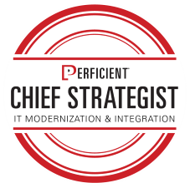In our previous blog post, Create Your Transformation Roadmap for Application Modernization, we looked at what a transformation roadmap typically includes w ith regard to app modernization. In this blog, we’ll examine the importance of transformation roadmaps, what they include, and the process of creating one.
ith regard to app modernization. In this blog, we’ll examine the importance of transformation roadmaps, what they include, and the process of creating one.
Why is creating a transformation roadmap so important?
At its core, a roadmap ensures the organization is moving toward its goal while also hitting markers along the way. The roadmap provides direction – both on the work you will do and the budget needed to achieve your goal. You’re essentially looking to marry strategy and architecture and accomplish all of the steps needed along the way with your roadmap.
By design, this roadmap aims to help you fill skills gaps and mature three main areas – your people, processes, and technology. As such, the final goal you work toward is broken up into many smaller goals to help progress in these areas. For example, if your organization wants to increase the speed of the application lifecycle, you may have a goal of adopting a DevOps methodology to do so. This goal would then include teaching people like the development and operations teams new skills, implementing new processes to encourage an agile environment, and adopting new technology to bring automation to your work.
The budget is also important to consider, because you have to play within the rules of your business. A roadmap helps you identify where you need to spend your budget and lays out a timeline to do so. This especially helps in getting executive buy-in for your efforts, where budget is often the first thing to come to mind. You may need to consider laying out a roadmap over multiple years because of your budget, while ensuring your plans align with business priorities is a must.
Those that don’t plan and gain executive support can often see their projects fail. They may miss the mark on some key aims: namely, struggling to adopt the technology and failing to mature skills and processes for the technology. These failures result in significant losses of both time and money.
Gain insight into similar companies’ business goals for application modernization. Take this quick survey to see how you compare.
Key components of a transformation roadmap
As highlighted in the previous blog in this series, a transformation roadmap typically includes:
- Your organization’s goals and barriers
- Journey maps for your customer experience
- Assessment and inventory of your technology
- Gap analysis and recommendations
- IT goals (e.g., cloud first, agile, DevOps)
- Technology options and reference architecture
- Application portfolio rationalization and migration options (e.g., build versus buy)
- Budgets, benefits, and timelines
- Change and communication plans
- Program governance (e.g., organization, roles and responsibilities, dashboard KPIs, accountability)
- Digital products and marketplace offerings
- Program execution in the context of goals (e.g., agility, innovation, DevOps)
The key behind the roadmap is showing why the business is investing in the application modernization efforts. How will your end goal benefit the business, and why did you choose the goals along the way as priorities?
Where you’re categorizing apps as part of your roadmap, it’s important to consider both business and IT attributes. These include:
Business metrics:
- Business domain
- Strategic focus/investment themes
- Operational effectiveness
- Revenue generation
- Usage/user count
- Relative user experience
IT metrics:
- Support costs
- Data and integration quality
- Architecture alignment
- Code quality
- Reliability
- Agility
- Security
Who is involved in creating the transformation roadmap?
A roadmap requires buy in from several stakeholders throughout an organization, which means many people are involved in creating it. First, as previously mentioned, you need to align your goals with business goals, which means you need to take a top-down approach to figure out what you want to achieve. As such, you will need executive buy-in and final reviews when it comes to launching the plan.
When looking at specifics, you’re going to have to work with teams to know what progress needs to be made in their areas. Interviews with application teams are necessary for specific business domains. You also need to review architecture and processes such as testing and change management, as well as input from operations, compliance, and security. The goal of this is to essentially understand how IT aligns with the business and ensuring that it is an innovative team that works toward business goals.
Many organizations don’t have experience with creating a roadmap, and may look to a partner to assist. As an experienced partner, we have the people with the experience and skills to lead and participate as subject matter experts in any application modernization project, along with a methodology with reusable templates and reference architecture.
Learn more about app modernization
Click here or fill out your details below to download our guide and learn more about how modernizing your apps can help your business.

